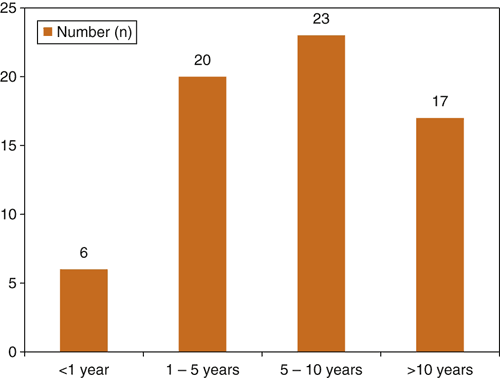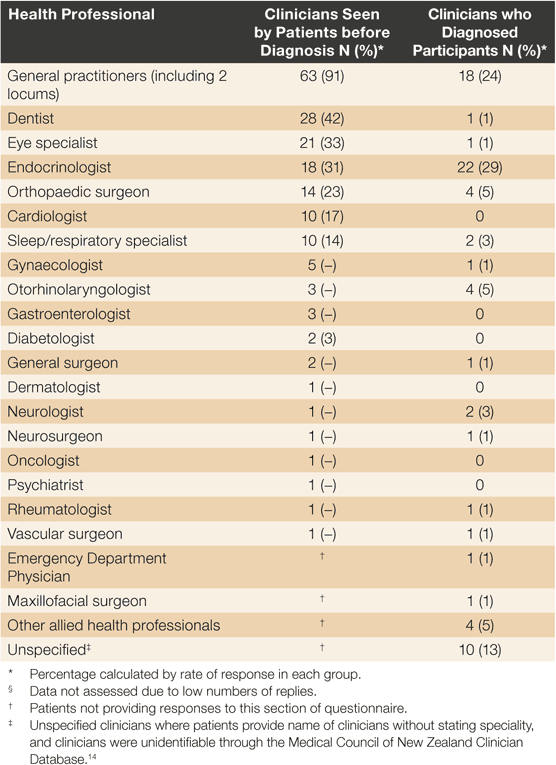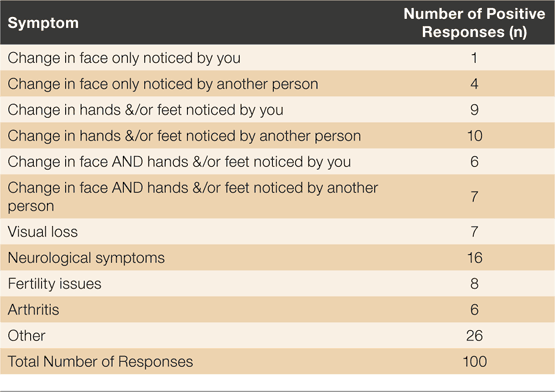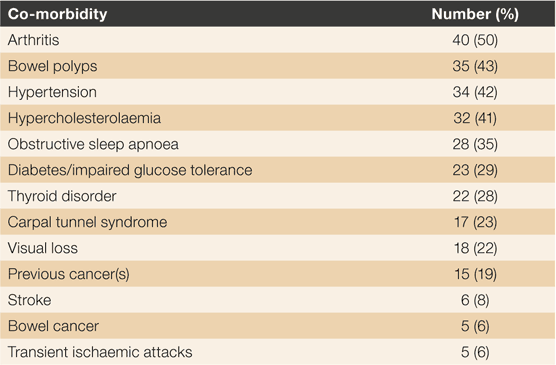Symptoms and signs of acromegaly: an ongoing need to raise awareness among healthcare practitioners
Redzuan Zarool-Hassan 1 , Helen M. Conaglen 2 , John V. Conaglen 2 , Marianne S. Elston 1 2 31 Department of Endocrinology, Waikato Hospital, Private Bag 3200, Hamilton, New Zealand
2 Waikato Clinical Campus, University of Auckland, Hamilton 3240, New Zealand
3 Correspondence to: Dr Marianne S Elston, Department of Endocrinology, Waikato Hospital, Private Bag 3200, Hamilton 3240, New Zealand. Email: Marianne.Elston@waikatodhb.health.nz
Journal of Primary Health Care 8(2) 157-163 https://doi.org/10.1071/HC15033
Published: 30 June 2016
Journal Compilation © Royal New Zealand College of General Practitioners 2016.
This is an open access article licensed under a Creative Commons Attribution-NonCommercial-NoDerivatives 4.0 International License.
Abstract
INTRODUCTION: Chronic excess growth hormone production results in acromegaly, a condition associated with widespread physical changes, including soft tissue and bony overgrowth. When untreated, acromegaly reduces life expectancy. Patients usually remain undiagnosed for years after the onset of symptoms, by which stage irreversible physical changes have often occurred.
METHOD: A cross-sectional questionnaire study involving patients with acromegaly from the Waikato Endocrine Unit and the New Zealand Acromegaly Society evaluated features of acromegaly that were present before diagnosis. The aim of this study was to identify acromegaly features that were most prevalent to promote increased awareness about the disease by healthcare providers.
RESULTS: 81 participants were included. The main pre-diagnosis physical changes participants reported were acral changes, alterations in facial features and oral symptoms. For some, these features were present for more than 10 years before the acromegaly diagnosis. Multiple co-morbidities associated with acromegaly were reported. Two-thirds of the participants felt that an earlier diagnosis was possible. Most participants were in contact with General Practitioners (GPs) and/or dentists before diagnosis. Endocrinologists had the highest diagnosis rate, followed by GPs. Dentists had a low diagnosis rate despite a high prevalence of oral symptoms among study participants.
CONCLUSION: Increased awareness of acromegaly among primary care clinicians is important as they are the first-point-of-contact with the healthcare system for most patients. Health professionals’ early recognition of symptoms and signs of acromegaly would reduce delays in time-to-diagnosis, enable earlier treatment and may improve outcomes for patients with acromegaly.
MESH KEYWORDS: Acromegaly; symptoms; delayed diagnosis; clinicians; primary healthcare
| WHAT THIS GAP FILLS |
| What we already know: |
| Acromegaly, characterised by chronic excess growth hormone production, results in widespread soft tissue and bony overgrowth, and is associated with premature mortality. Disease onset is insidious and diagnosis is often delayed many years after symptom onset. |
| What this study adds: |
| Despite advances in medicine, patients with acromegaly are still diagnosed late, usually 5–10 years after symptom onset and frequently > 10 years. Adults reporting enlargement of the hands and feet and/or altered facial morphology with increased jaw size should trigger consideration of acromegaly and measurement of an IGF1 level. |
Introduction
Acromegaly is invariably due to excess growth hormone (GH) secreted by a pituitary adenoma and results in increased serum insulin-like growth factor I (IGF-I) levels. Excess GH exposure is characterised by end-organ effects, in particular, soft tissue and bony overgrowth. Acromegaly is rare, with a reported annual incidence of 3–4 per million and a population prevalence of 60 per million, although more recent studies suggest that the prevalence may be much higher.1 This, coupled with insidious disease progress and non-specific symptoms, often leads to a marked delay in diagnosis, reported to range between 5 to 10 years after onset of symptoms.2 Despite technological advancement in diagnostic methods to detect the disease, a delay in diagnosis continues to be an issue due to under-recognition of the clinical features by health professionals.3
The diagnosis of acromegaly requires clinicians to consider the possibility of this disorder and measure a serum IGF-1 level, which will usually confirm or exclude the diagnosis. Confirmatory blood testing includes assessment of GH suppression following an oral glucose load followed by assessment of other pituitary hormones, tumour size by MRI imaging and co-morbidities such as visual field loss.
When untreated, acromegaly is associated with an increase in mortality, such that patients with uncontrolled GH excess die on average 10 years younger than predicted.2 Acromegaly is also associated with cardiovascular, cerebrovascular, metabolic, orthopaedic, ophthalmic and respiratory co-morbidities as well as increased rate of various malignancies,4 which have a detrimental impact on patients’ quality of life. Many of these changes, in particular osteoarthritis, are irreversible even with correction of GH excess.5 Therefore, early diagnosis of acromegaly is important and improves outcomes, including reducing overall mortality risk.6 Timely diagnosis also enables earlier intervention for the co-morbidities associated with acromegaly, consequently preventing progression to more advanced disease.
Acromegaly is a condition in which earlier diagnosis could be enabled by greater awareness of acromegaly symptoms and greater collaboration between general practitioners (GPs) and dentists. There is no formal integration of care between dentists and GPs: patients usually attend their GP for health-related symptoms and are sometimes referred to a hospital consultant if needed. Patients with dental symptoms may see a dentist, but there is no routine communication between dental and general practice services.
The aim of this study was to identify features of acromegaly that were most prevalent among patients at diagnosis. By drawing attention to these findings, an increased awareness of the features of acromegaly by health care professionals may be facilitated, enabling earlier diagnosis and treatment.
Methods
Patients with acromegaly were identified from the Waikato Endocrine Department and The New Zealand Acromegaly Society. Patients were invited to participate in the study at face-to-face routine clinic visits, by mail and email. The Waikato Clinical School summer studentship committee peer reviewed the project. The study was of minimal risk and therefore did not require formal ethics review. It was conducted in accordance with the National Health Advisory Committee’s Ethical Guidelines for Observational Studies, and with permission of the Waikato Endocrine Department.
Questionnaires were distributed to 98 participants in either hardcopy or online (via a GoogleTM Documents hyperlink) during the period November 2012 to July 2014. Sixty-five questionnaires were distributed to members of the New Zealand Acromegaly Society; the remainder to patients seen in clinic at the Waikato Endocrine Department. Data received were anonymous.
The online questionnaire was in sections covering pre-designated domains that required responses before participants proceeded to subsequent sections of the questionnaire. This encouraged participants to answer all questions and increased rates of response for each domain. However, it was not possible to apply such techniques to paper questionnaires. Therefore, the number of responses to each question has been reported to enable meaningful evaluation and interpretation of response. As recall bias may be a limiting factor of reliable symptom reporting we also determined the reported time between diagnosis and questionnaire completion.
All completed questionnaires were collated in Microsoft Excel ©, then analysed using Statistica Version 11 (Statsoft Inc., Tulsa, OK, USA).
Results
Demographics
The response rate was 83% (81/98). A total of 83 responses were received during the study period, but 2 were excluded as they were duplicates. Of the 81 participants, 12 (15%) completed the questionnaire online and 69 (85%) completed the hardcopy questionnaire.
Participants were 51% female, 48% male (1 unspecified gender entry). Mean age was 58.6 years (s.d. 13.2 years). Patients aged 61–70 years formed the largest group. Ethnicity was reported in 78 patients: 64 (82%) were of New Zealand European descent. Median time since diagnosis was 7 years (range 0–47 years).
At the time of diagnosis, most participants were aged 41 to 50 years (Figure 1). The duration of symptoms is shown in Figure 2 and Table 1. Most patients had symptoms 5–10 years before diagnosis and 26% of patients had symptoms for over 10 years.

|

|
Diagnosis of Acromegaly
Concerns raised by a doctor or other health professional prompted the diagnosis of acromegaly in 42/80 participants, patient concerns in 24/80 and from a family member in only 2/80. Multiple factors led to diagnosis in 13/80. Two-thirds of participants (48/72) reported that they considered an earlier diagnosis could have been possible.
Almost all participants had visited their GP before the diagnosis of acromegaly was made, and dentists were the second-most visited health professional in this study. Other health professionals visited by the participants are shown in Table 2. Endocrinologists were reported to be the health professionals most likely to confirm the diagnosis of acromegaly.

|
Participants also provided feedback into their experience before being diagnosed with acromegaly as shown in Table 3, where there were common themes around diagnostic delay and feelings of frustration with the healthcare system.

|
Features of Acromegaly and Co-Morbidities at Time of Diagnosis
Symptoms triggering medical attention and subsequent diagnosis of acromegaly are detailed in Table 4. Some participants provided more than one answer to this section. The most common symptoms were related to acral overgrowth, namely an increase in hand, foot and/or shoe size, as well as facial feature changes. Symptoms due to mass effects of the pituitary adenoma, such as headaches and vision disturbance were reported in 54% and 32% of the participants, respectively. Table 1 lists features present before diagnosis in order of prevalence as reported by study participants.

|
The co-morbidities present in study participants are listed in Table 5. Arthritis was the most prevalent co-morbidity reported by participants, followed by bowel polyps, hypertension and hypercholesterolaemia.

|
Discussion
This study highlights that most patients have symptoms for many years before the diagnosis of acromegaly. It was extremely uncommon for the diagnosis to be made within one year of symptom onset. The fact that most participants had visited GPs and dentists before their diagnosis implies that these clinicians had the opportunity to detect patients with acromegaly earlier than others. Therefore, given their role as gatekeepers of the healthcare system, awareness of acromegaly is important in allowing prompt diagnosis of patients and early referral for treatment.
Participants identified three salient physical features of acromegaly, namely acral changes (enlarging hands and/or feet), altered facial features (e.g. prominent brow, increased jaw) and oral symptoms (increased size of tongue, splaying of teeth and altered bite). These symptoms can be identified from history and physical examinations during clinic visits. A third of participants (37%) were investigated further after presenting with a chief complaint related to acral changes. Concern from doctors and other health professionals was the major factor prompting diagnosis of acromegaly among half of participants.
Facial and oral symptoms were common and can continue unnoticed for many years due to the subtlety of facial feature changes, that patients themselves fail to identify until much later during the disease course. Even patients’ regular clinicians may miss these symptoms in early visits before diagnosis. In fact, two participants who regularly saw their GPs were diagnosed only after chance encounters with locum GPs, visited for reasons unrelated to acromegaly. Diagnosis appeared to be made earlier in patients presenting with facial symptoms compared to acral symptoms. This is possibly because facial changes were more obvious (and perhaps more debilitating) and noticed earlier than changes in their hands and/or feet.
Acromegaly is associated with multiple co-morbidities resulting in multi-organ symptoms.3,4 Therefore treating clinicians need to be aware that the more common co-morbidities of acromegaly, such as arthritis or hypertension, may well be a hallmark of acromegaly and should raise suspicion if patient profiles fit with the disease characteristics.
In this study, endocrinologists were the clinicians most likely to make the diagnosis of acromegaly, e.g. when seeing a patient for thyroid disease. This is most likely due to an increased awareness of the condition among endocrinologists (as would be expected). GPs were the second most likely group to diagnose patients with acromegaly. Despite being the second-most visited healthcare professional in our cohort, and given that half of participants report oral symptoms, dentists were reported to have made the diagnosis for only one patient. These findings are comparable to another study investigating medical professionals visited by patients before diagnosis and their rate of diagnosing acromegaly.7 Siegel et al. also reported that despite a third of patients with acromegaly seeking care from dentists, the diagnosis was not considered.8 This raises the question of whether adequate awareness about acromegaly is present among dentists, despite the prevalence of oral symptoms in patients with the disease.
One limitation of the current study is that participants’ responses were not confirmed with patients’ medical records, so results may be affected by recall bias. In some patients several decades had passed since diagnosis so this is likely to have influenced recall and potentially accuracy of some answers.
Several methods to assist screening for acromegaly have been proposed. In a primary healthcare study, 17 000 patients were screened using a questionnaire that evaluated enlargement of extremities.9 Although pre-test probabilities of the questionnaire were not made available, the authors proposed that screening based on phenotypic changes is cost-effective. However, population screening for acromegaly using biochemical assays have a low detection rate and incur unnecessary costs.10 In the DETECT study, among 6773 adult primary care patients in whom an IGF-1 measure was performed, 125 patients or 1.85% of the study population had elevated IGF-1 levels necessitating further evaluation. Of those, seven had investigation results consistent with acromegaly; (one patient was previously known to have acromegaly, for two patients testing led to a new diagnosis and four had biochemistry consistent with the diagnosis but declined further testing). Of the remainder, 42 had acromegaly excluded and 76 had indeterminate results. It is uneconomical to perform routine IGF-1 testing on every patient in general practice given the low prevalence of acromegaly in the population (a single IGF-1 test costs approximately NZD57.00 as at November 2014).11 Furthermore, unnecessary routine testing may also lead to patient anxiety and thereby cause harm.
In recent years, new methods have been devised to improve the detection rate of acromegaly, including computerized face detection.12 A software program has been shown to have a higher accuracy in detecting acromegalic facial features than medical experts or general internists especially among patients with mild acromegaly.13 Although a promising tool, such techniques are not currently feasible to detect acromegaly in primary care due to cost restraints and lack of equipment availability. Use of this in a New Zealand population has also not been assessed and the sensitivity and specificity may differ for patients from various ethnic backgrounds.
Ultimately, raising awareness of acromegaly among primary healthcare clinicians remains a simpler yet more practical approach to improving the early diagnosis of the disease. Simple measures such as handouts, awareness campaigns and close relations with local acromegaly societies may still be the most effective approaches. Both medical and dental schools could also emphasise the disease in their curriculum. We recommend that if the diagnosis of acromegaly is entertained when meeting a patient, that further questioning should be performed and any suggestive symptoms should result in measurement of a serum IGF-1 or a phone call to the local endocrine team for advice.
CONFLICT OF INTERESTS
The authors report no conflict of interest in this study.
ACKNOWLEDGEMENTS
The authors thank all participants and in particular Dr Catherine Chan of The NZ Acromegaly Society.
References
[1] Holdaway IM, Rajasoorya C. Epidemiology of acromegaly. Pituitary 1999; 2 29–41.| Epidemiology of acromegaly.Crossref | GoogleScholarGoogle Scholar | 1:STN:280:DC%2BD3M%2FksFKjtA%3D%3D&md5=a22b4ae9ea142c47deb6a5aa827a6b5eCAS | 11081170PubMed |
[2] Rajasoorya C, Holdaway IM, Wrightson P, Scott DJ, Ibbertson HK. Determinants of clinical outcome and survival in acromegaly. Clin Endocrinol (Oxf) 1994; 41 95–102.
| Determinants of clinical outcome and survival in acromegaly.Crossref | GoogleScholarGoogle Scholar | 1:STN:280:DyaK2czis1eqtQ%3D%3D&md5=9cd50723c514933f574f3ab8c0476584CAS | 8050136PubMed |
[3] Reid TJ, Post KD, Bruce JN, Nabi Kanibir M, Reyes-Vidal CM, Freda PU. Features at diagnosis of 324 patients with acromegaly did not change from 1981 to 2006: acromegaly remains under-recognized and under-diagnosed. Clin Endocrinol (Oxf) 2010; 72 203–8.
| Features at diagnosis of 324 patients with acromegaly did not change from 1981 to 2006: acromegaly remains under-recognized and under-diagnosed.Crossref | GoogleScholarGoogle Scholar | 19473180PubMed |
[4] Katznelson L, Atkinson JL, Cook DM, Ezzat SZ, Hamrahian AH, Miller KK. American Association of Clinical Endocrinologists medical guidelines for clinical practice for the diagnosis and treatment of acromegaly – 2011 update. Endocr Pract 2011; 17 636–46.
| American Association of Clinical Endocrinologists medical guidelines for clinical practice for the diagnosis and treatment of acromegaly – 2011 update.Crossref | GoogleScholarGoogle Scholar | 21846619PubMed |
[5] Claessen KM, Ramautar SR, Pereira AM, Romijn JA, Kroon HM, Kloppenburg M, Biermasz NR. Increased clinical symptoms of acromegalic arthropathy in patients with long-term disease control: a prospective follow-up study. Pituitary 2014; 17 44–52.
| Increased clinical symptoms of acromegalic arthropathy in patients with long-term disease control: a prospective follow-up study.Crossref | GoogleScholarGoogle Scholar | 1:STN:280:DC%2BC3szhslWmug%3D%3D&md5=72f9bede5fcba86ccd626006649e8e22CAS | 23344976PubMed |
[6] Holdaway IM, Bolland MJ, Gamble GD. A meta-analysis of the effect of lowering serum levels of GH and IGF-I on mortality in acromegaly. Eur J Endocrinol 2008; 159 89–95.
| A meta-analysis of the effect of lowering serum levels of GH and IGF-I on mortality in acromegaly.Crossref | GoogleScholarGoogle Scholar | 1:CAS:528:DC%2BD1cXhtVOhs7vL&md5=2c1cf562c44a219952960308c711efccCAS | 18524797PubMed |
[7] Aydin K, Cinar N, Dagdelen S, Erbas T. Diagnosis of acromegaly: Role of the internist and the other medical professionals. Eur J Intern Med 2014; 25 e25–6.
| Diagnosis of acromegaly: Role of the internist and the other medical professionals.Crossref | GoogleScholarGoogle Scholar | 24157180PubMed |
[8] Siegel S, Streetz-van-der-Werf C, Schott J, Nolte K, Karges W, Kreitschmann-Andermahr I. Although dentists are frequently visited by acromegaly patients they do not diagnose the disease. Endocrine Abstracts. 2012; 29 1493
[9] Rosario PW, Calsolari MR. Screening for acromegaly by application of a simple questionnaire evaluating the enlargement of extremities in adult patients seen at primary health care units. Pituitary 2012; 15 179–83.
| Screening for acromegaly by application of a simple questionnaire evaluating the enlargement of extremities in adult patients seen at primary health care units.Crossref | GoogleScholarGoogle Scholar | 21380935PubMed |
[10] Schneider HJ, Sieverst C, Saller B, Wittchen HU, Stalla GK. High prevalence of biochemical acromegaly in primary care patients with elevated IGF-1 levels. Clin Endocrinol (Oxf) 2008; 69 432–5.
| High prevalence of biochemical acromegaly in primary care patients with elevated IGF-1 levels.Crossref | GoogleScholarGoogle Scholar | 1:CAS:528:DC%2BD1cXhtFentbzP&md5=d593c3bb8c4b3ddae36f0178a47f028eCAS | 18284644PubMed |
[11] Labtests – Specimen Collection Guide and Price List. 25 November 2014. Retrieved on 5 December 2014 from: http://www.labtests.co.nz/images/Referrers/Tests/Specimen_Collection_Guide.pdf.
[12] Miller RE, Learned-Miller EG, Trainer P, Palsley A, Blanz V. Early diagnosis of acromegaly: computers vs clinicians. Clin Endocrinol (Oxf) 2011; 75 226–31.
| Early diagnosis of acromegaly: computers vs clinicians.Crossref | GoogleScholarGoogle Scholar | 21521289PubMed |
[13] Schneider HJ, Kosilek RP, Gunther M., et al. A novel approach to the detection of acromegaly: Accuracy of diagnosis by automatic face classification. J Clin Endocrinol Metab 2011; 96 2074–80.
| A novel approach to the detection of acromegaly: Accuracy of diagnosis by automatic face classification.Crossref | GoogleScholarGoogle Scholar | 1:CAS:528:DC%2BC3MXptlSrsbc%3D&md5=3ce37ac01fa214326108a58d403de202CAS | 21508144PubMed |
[14] List of Registered Doctors. Medical Council of New Zealand. Information accessed through https://www.mcnz.org.nz/support-for-doctors/list-of-registered-doctors/.



